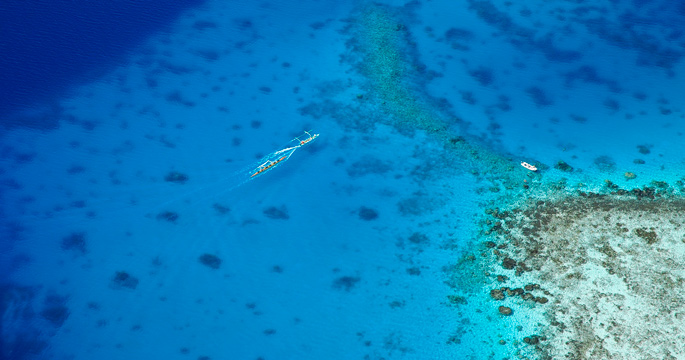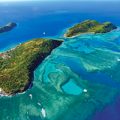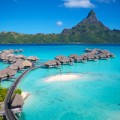A first-timer's guide to the Islands of Tahiti
Tell someone you are off to Tahiti and they will probably be jealous. But only a savvy few will follow up with the question “Which Island?” Tahiti is an island, but you’ll also hear the phrase “The Islands of Tahiti.” Or you may hear about the islands of French Polynesia. So which is it? In case you’ve always wanted to go, but aren’t clear on where to go, here’s a simple guide to discovering the world’s favorite South Pacific paradise.
Know Your Islands
The more than 100 major islands that are collectively known as French Polynesia are all part of an Overseas Collectivity of the Republic of France. These islands stretch more than 1,200 miles across a broad swath of the Pacific Ocean, and are divided into five main groups: the Marquesas Islands, Tuamotu Archipelago, Gambier Islands, Austral Islands and Society Islands. It is this last group that we’ll be focused on, and it’s also the group that welcomes more than 90 percent of all travelers. The Society Islands are the stuff of postcards and screen savers, with towering green volcanoes and aquamarine fringing reefs. This is the land of over-water bungalows, waterfall hikes and outrigger canoe trips to deserted beaches. There are five unique island destinations in the Society group that travelers can choose between, and each has its own special charms.
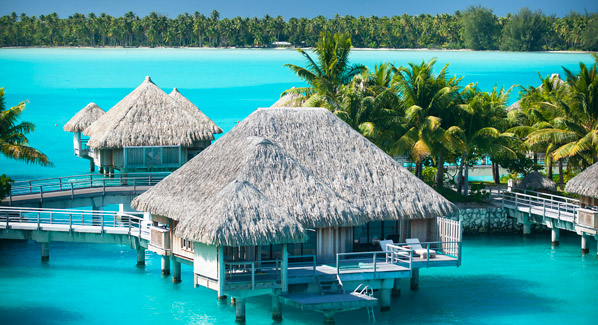
An over-water bungalow at the St. Regis Bora Bora. Over the years, these iconic structures have evolved into luxurious accommodations with unique features such as glass viewing floors and on-deck plunge pools. Photo: St Regis
Tahiti – The Big Island
At the center of French Polynesia is the island of Tahiti itself. Unless you are arriving by boat, all travel to French Polynesia begins with a flight into Faa’a International Airport on the Island of Tahiti. This island is also the seat of government, and the capital city of Papeete. Arriving travelers who are transferring to other islands might want to add a few days to explore Tahiti itself. Papeete’s vibrant open-air markets are a show unto themselves, and the dining scene offers a savory range of Tahitian, French and Asian cuisines. The two highest peaks in Polynesia—Mount Orohena and Aorai—soar more than a mile above lush tropical forests where hiking trails through coconut groves and thickets of bougainvillea lead the way to cascading waterfalls.
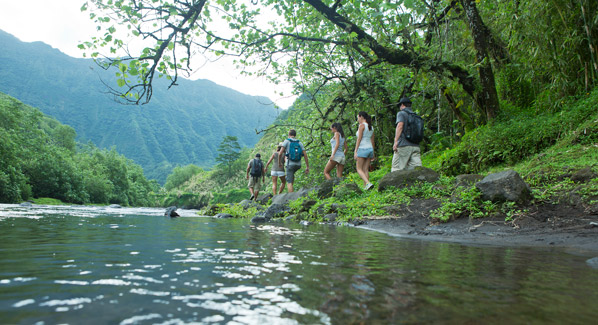
Hikers follow a stream towards the mountainous interior of Tahiti. As the largest and highest island in Polynesia, it offers hikers and climbers a wide range of adventures. Photo Grégoire Le Bacon/Tahiti Tourisme
Bora Bora – The Crown Jewel
If there were a beauty contest for islands, Bora Bora would wear the tiara. And in a way, it does. The single emerald spire of iconic Mount Otemanu sits within a sparkling lagoon that is ringed by small islands known as motus. Scattered around this ring of palm trees and white sand beaches are a number of upscale resorts that feature spectacular over-water bungalows, where views of the central island peak are framed by the aquamarine lagoon. With resorts providing a combination of fine dining, world-class spas and luxurious accommodations, some guests are content to cloister in their bungalows. For the active and adventurous, the sheltered waters of the lagoon provide an aquatic playground for snorkelers and paddlers. Ashore, the island, though small, offers several unique hikes into the Valley of the Kings, and to elevated views from the slopes of Mount Otemanu. Bora Bora is reached by a 45-minute flight from the island of Tahiti.
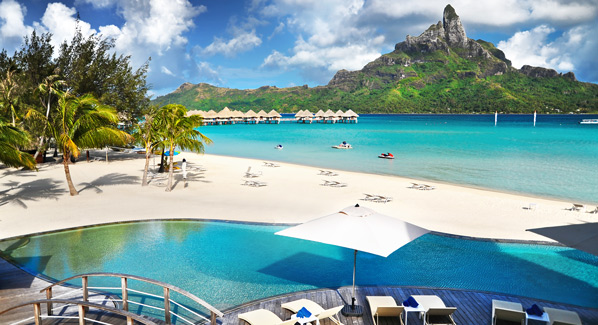
A view from the pool deck at Le Meridien Bora Bora Resort takes in views of the lagoon and Mount Otemanu. This iconic peak dominates the landscape from points all across the island. Photo: Le Meridien
Moorea – The Friendly Isle
Just ten miles to the west of Tahiti’s bustling capital of Papeete, the island of Moorea moves at a slower pace. The island’s shores offer dazzling white sand beaches and shady lagoons, all set within an encircling ring of coral reef. Inland, lush valleys hide picturesqueness villages, and narrow roads lead upward through pineapple fields into forested slopes where waterfalls cascade from the central peaks. Complementing this bucolic landscape are a number of mid to upper-end resorts scattered along the coast. Hospitality comes naturally to the people of Moorea, who are known for their warm and inviting personalities. Snorkeling, diving and sailing are favorite activities for many guests, along with unique opportunities to join paddling crews to explore the shore in a traditional outrigger canoe. Ashore, there are tours of villages and plantations, hikes into secluded inland valleys, and off-road drives to elevated view points to take in stunning views of island and ocean. Because Moorea is quite close to the Island of Tahiti, most visitors arrive by ferries departing from the Papeete waterfront.
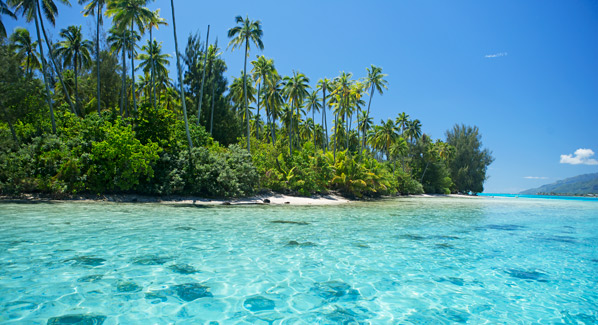
A small island known as a motu sits at the outer edge of Moorea’s lagoon. Many of these islands remain uninhabited, and are a favorite destination for day trips. Photo Grégoire Le Bacon/Tahiti Tourisme
Huahine – The Garden Spot
Though far less visited than Bora Bora or Moorea, Huahine offers both scenic and cultural rewards for those who make the half-hour flight from Tahiti. Much of the island remains forested or planted in vanilla plantations, banana groves, orchards and taro fields. Coconut palms tower over deserted beaches, and small outlying motus become idyllic destinations for beach picnics. Huahine is actually two islands, separated by a narrow channel that is spanned by a single bridge. A handful of resorts are scattered around the shoreline, and intimate local guesthouses provide a chance to experience true island life. Visitors can go to local markets and fishing villages where they will be welcomed into a simpler way of life. Huahine is also noted for it’s numerous archaeological sites, which include the remains of ancient stone cities and fishponds created for Tahitian royalty. Also unique to the island are the sacred blue-eyed eels that live in Lake Fauna Nui.
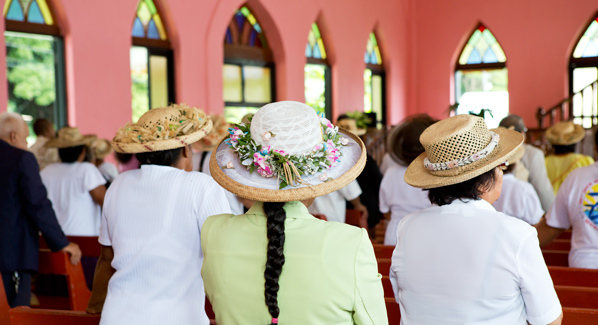
Worshipers gather for a Sunday service on the island of Huahine. Modern Tahitian culture blends ancient Polynesian traditions with European influences. Photo Grégoire Le Bacon/Tahiti Tourisme
Raiatea and Tahaa – The Sacred Homeland
Once known as Havai’i, the homeland, Raiatea is believed by many to be the genesis for the great Polynesian migration that launched sailing canoes to colonize new shores from New Zealand to Hawaii. It is very much an island steeped in history and legend, and it is also stunningly beautiful, with an expansive lagoon that also encompasses the sister island of Tahaa, and a number of islets scattered across a vast lagoon. Most of these are small and uninhabited, while several are home to secluded, luxurious resorts. The expansive size and sheltering waters of the Raiatea lagoon make it a favorite with sailors, and several sailboat charter companies operate along the island’s shores. The island is served by daily flights from Papeete, while neighboring Tahaa can only be reached by boat. This most remote member of the Society Island group is sometimes called the Vanilla Isle, because it is the source of more than 75 percent of all Tahitian vanilla production.
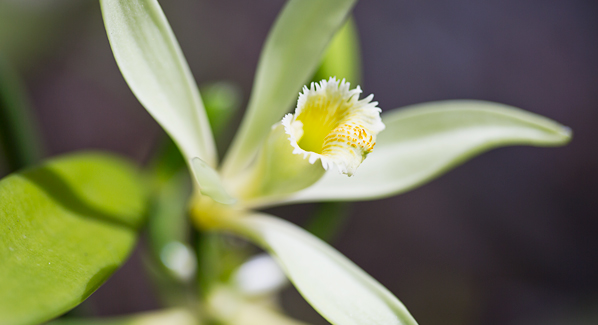
A close up shot of a vanilla blossom. The islands of Tahiti are known for producing a very aromatic strain of this spice, which can command premium prices on the world market. Photo Grégoire Le Bacon/Tahiti Tourisme

